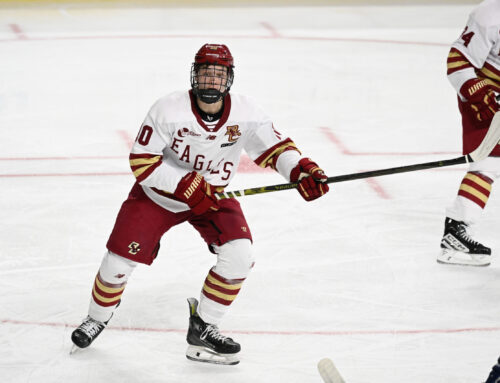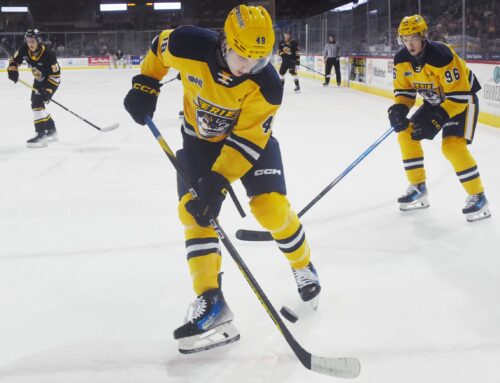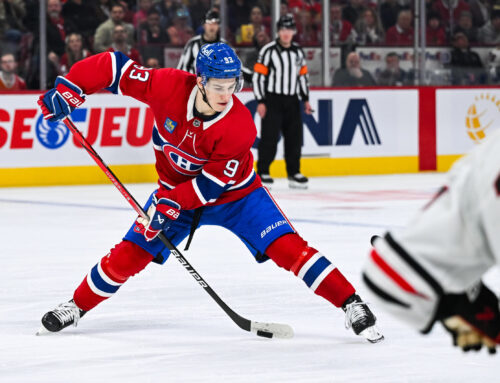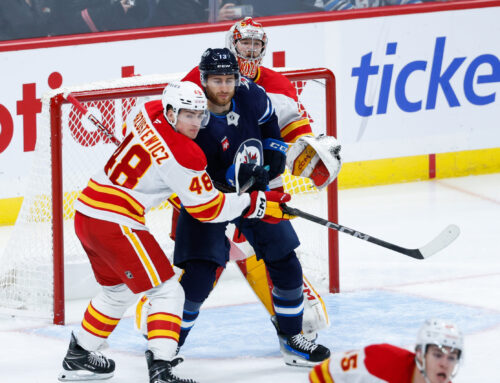Welcome back to The Journey, where we track the development of prospects as they excel in junior, make the NHL, and push towards stardom.
Last week, I profiled the new Frozen Tools AHL Report Generator, highlighted a smart thread about how dramatically a prospect's chances of making the NHL drop with a rocky transition to the AHL in their D+2, and delved into some older players, including: Adam Beckman (MIN), Emil Benstrom (CBJ), Matthew Phillips (WAS), Alexander Nylander (PIT), Trey Fix-Wolansky (CBJ), Scott Perunovich (STL), and Lucas Carlsson (FLA).
*****
First off, I know you've already seen it, but watch Logan Cooley's (ARI) filthy spin move one more time. This guy is going to be a serious problem for opposing defences this year and should keep the Calder race interesting alongside Adam Fantilli (CBJ) and Connor Bedard (CHI).
Dynamic young players steadily changing how the game is played. I absolutely love it.
*****
Is the AHL the second-best professional hockey league in the world?
I came across an interesting thread this morning about the AHL's relative strength compared to other non-NHL professional leagues:
I had been operating under the assumption that the top five went like this:
- Kontinental Hockey League (KHL, Russia)
- American Hockey League (AHL)
- Swedish Hockey League (SHL)
- Liiga (Finland)
- National League (Switzerland) / Del (Germany)
But as McCallum points out, that assumption was informed by NHL equivalency tables, which "estimate how much one point in each league is worth relative to an NHL point."
The problem is that NHLe models do not take into account the relative scarcity of scoring in these leagues. It is harder to score in the KHL, for instance, so a point in the Russian league translates better to the NHL. How well a point from a given league translates to NHL production, however, is a different question than how strong that league is.
Focusing in on this second question in particular, McCallum suggests that the actual top five "best" non-NHL professional leagues are:
- AHL
- SHL
- NL
- KHL
- Czechia / Liiga / Del
This insight adds extra weight to Byron Bader's point that a player's transition to the AHL out of junior in their Draft+2 year is absolutely critical. If that goes well—if their NHLe drops less than 20% or even improves that year—then they have a much better shot at making and excelling in the NHL than otherwise.
*****
Now let's take a closer look at the 2022-23 AHL performances of some exciting prospects aged 21-23. Individual Point Percentages (IPP) and consistency insights taken from the Frozen Tools AHL Report Generator.
Jakob Pelletier (CGY), 22
Pelletier scored 37 points in 35 AHL games last year before getting called up to the parent club and putting up a 24-point-pace across 24 NHL games with the Flames. He has been a slow burn across a number of years, playing for four years in the QMJHL and then a couple in the AHL. The thing about Pelletier is that, despite his relatively slight 5-9 170-pound frame, he has lit up the scoresheet at every level—usually immediately: he exceeded a point-per-game (ppg) in his D-1 in the Q and finished just under a ppg as an AHL rookie.
This past year in the AHL, Pelletier was one of the most consistent producers league-wide, scoring in an impressive 68.57% of the games that he played in. His 74 IPP further shows that he figured into a good portion of the goals his team scored with him on the ice.
Even under the Darryl Sutter regime in 2022-23, Pelletier saw 70% of his shifts alongside some combination of Jonathan Huberdeau, Elias Lindholm, Tyler Toffoli, and Nazem Kadri. All of those combos drove play very well (+62% CorsiFor), so even—or especially—with the coaching change, I think we can expect top-six deployment for Pelletier right out of the gates, assuming he shows well in training camp.
In the Dobber Fantasy Guide, we have Pelletier down for 34 points in 78 games with 15% chance of hitting 60 points. That's a Calder dark horse if I ever saw one.
Marco Rossi (MIN), 21
Rossi, Rossi, Rossi. I have written about this guy so many times over the past few years that there really isn't much more to say at this point. The question on everyone's minds these days is whether he can finally break through into the NHL for good. He has proven for two years now that he is more than good enough for the AHL (104 points in 116 games) but has struck out almost completely over his first 21 NHL games (one assist), albeit never really playing with Minnesota's top guns.
It's always good to take the "he's in the best shape of his life" stories with a grain of salt, but Michael Russo at The Athletic put out an excellent story recently on Rossi's dedication to his training during the off-season. He was always known as a fiery, determined gym rat, and that commitment hasn't gone anywhere.
Similar to Pelletier, we have him down in the Guide for 34 points in 73 games with a 15% chance at hitting 50. Patience will have to continue to be the mantra for Rossi owners: as an undersized player, he could need up to five NHL seasons (400 games) to realize his considerable upside. Dobber still thinks he has the potential to hit 95 points someday, and I'm inclined to agree. He continues to be an excellent buy-low candidate, especially if he struggles again in the NHL to start 2023-24.
Jordan Spence (LAK), 22
Spence has posted impeccable AHL numbers over the past two seasons (87 points in 102 games), which included scoring in 62.5% of his games in 2022-23. He is a consistent, high-end playmaker from the back end who has also become more of a shooting threat of late (3 shots/game), despite continuing to post low goal totals (4 goals in 56 games).
He is facing a training camp battle with mega-prospect Brandt Clarke, who is coming off an OHL victory lap in which he absolutely feasted on the competition to the tune of two points per game as a defenceman. That will indeed be a challenge, as they are both right-handed defenders, but Spence is older and more seasoned. Despite Clarke's scoring prowess, it would not be a surprise to see Spence win the third-pairing job at least initially.
He has looked excellent so far in preseason action. Check out this poise and patience with the puck:
Semyon Der-Arguchintsev (TOR), 23
A victim of the numbers game in Toronto, SDA has returned to Russia this year to play in the KHL with Traktor, where he already has six points in only 10 games. His NHL rights are still owned by the Leafs, at least for now, and he certainly appears to be an NHL-calibre prospect.
He scored 40 points in 50 games with the Marlies last year, posting a consistency rating of 62%, so the offensive side of his game has never been in doubt. On the defensive end, however, there have been concerns: he posted a team-worst -12 rating in 2021-22, and though he improved on that front last year, his small frame and defensive inconsistencies likely contributed to his lack of NHL call-ups (only one game).
His contract with Traktor runs through the 2024-25 season, so if he returns to the NHL it will be as a well-seasoned 2024-25 year old. Don't hold your breath, but watch his development in Russia closely. If his production continues at his current rate, he could start raising eyebrows again in fantasy.
Alex Steeves (TOR), 23
Steeves finished second in scoring on the Marlies last year to career minor leaguer Logan Shaw, posting 51 points in 65 games with a consistency rating of 61.54%. He is heading into the final year of his three-year Entry-Level Contract, after which he will be a Restricted Free Agent.
Like many Leafs prospects, Steeves is seemingly getting lost in the shuffle in Toronto with all the hype around Matthew Knies and Nick Robertson, both of whom play on the left side like he does. With Tyler Bertuzzi, Max Domi, and Calle Jarnkrok already well-established at Left Wing, it looks like Steeves will be leading the Marlies in scoring again in 2023-24. The right side of the depth chart has much less heft behind Mitch Marner and William Nylander, however, so perhaps Steeves could see some NHL games this year due to injuries and/or shifting over to play on the right side of the ice.
I would counsel looking elsewhere for now in fantasy. Even with Steeves' scoring chops, it is doubtful that he can put up fantasy-worthy numbers even if he does squeak onto the fourth line for a portion of the upcoming campaign.
Georgi Merkulov (BOS), 22
Merkulov's career totals to date do not explain why he went undrafted: he has now gone nearly a point-per-game in the USHL, NCAA, and AHL in successive years—no easy feat.
For whatever reason, the Providence Bruins (AHL) roster last year was composed of prospects from seven NHL organizations, and although fellow Bruins prospect Fabian Lysell is a former first-rounder with much more hype and pedigree, it was Merkulov that led the Baby Bruins in scoring last year—in both goals (24) and points (55). Scoring in 61.19% of his games, he was also one of their most reliable producers.
And that was as an AHL rookie.
The other intriguing aspect with Merkulov is that he plays down the middle, a noted area of weakness for the parent club now with the departure of both Patrice Bergeron and David Krejci. He will have to shoot more moving forward (1.9 shots/game last year) to maintain his goal-scoring numbers, but his star certainly seems to be on the rise at the perfect time in Beantown.
Without AHL face off numbers, it is difficult to say whether the small-framed Merkulov (5-11, 179 lbs) can hack it up the middle at the highest level, but the opportunity is certainly there. Albeit without Pavel Zacha, the team's conceivable top C, in the line up today, it is an encouraging sign that Merkulov is seeing reps with Jake DeBrusk on the second line in camp.
Tye Kartye (SEA), 22
Kartye was the Kraken's biggest late-season success story in 2022-23. He put up 57 points in 72 AHL games (61% consistent) before joining the Kraken for the playoffs and scoring five critical points in ten games along with a whopping 44 hits. That was playing only 12 minutes a game in the bottom six, so there is a lot of room for improvement—especially with the departure of Daniel Sprong over the off-season.
Despite never being drafted, Kartye steadily improved his scoring totals over three OHL seasons before breaking seamlessly into the AHL last year. Even with Sprong's departure, there is no clear roster spot for Kartye on the left side, where he is blocked by Andrei Burakovsky, Jaden Schwartz, Eeli Tolvanen, and Brandon Tanev. Injuries will hit at some point, however, and you can expect to see Kartye making some noise in a Kraken jersey before long.
He likely has a more modest ceiling (~70 points) than the other top Kraken prospects like Shane Wright, Jagger Firkus, Eduard Sale, and even David Goyette but he is closer to contributing at the NHL level right now than all four except perhaps Wright.
Here he is scoring a devastating goal against my Avalanche last Spring:
Vasily Podkolzin (VAN), 22
There is no way around it: the Canucks made a big mistake taking Podkolzin tenth overall in the 2019 draft ahead of players like Matt Boldy (MIN), Spencer Knight (FLA), Cam York (PHI), Cole Caufield (MON), Alex Newhook (now with MON), Peyton Krebs (BUF), and Thomas Harley (DAL).

Podkolzin is probably still an NHL player but does not hold much value anymore as a fantasy asset. Although he hits (1.33/game), he barely shoots (1.05 shots/game) or scores, partly because he has not yet seen much ice time or skilled linemates. He drove play quite well in a sheltered role with the Canucks in 39 games last year but only scored seven points.
He was quite consistent in the AHL last year, scoring about 60% of the time, but 18 points in 28 games does not really scream "call up." At this point, the Canucks are likely hoping that Podkolzin and Nils Hoglander can at least turn into fiery, competitive middle-six depth pieces that can support the top end of the roster. If you can find a Vancouver fan who will bite on his pedigree, sell him while you can.
Phil Tomasino (NAS), 22
I've been bullish on Tomasino for years now, but wow is he ever starting to stretch my patience. 32 points in 38 AHL games last year (60% consistency) is solid, and he scored at nearly a 50-point pace across 31 NHL games in 2022-23.
But other prospects in the system (Luke Evangelista, Juuso Parssinen, Tommy Novak) are threatening to pass him now. He will have to come out of the gates strong to have a chance at top-six deployment in 2023-24. Dobber has him pencilled in as the Preds' second-line RW, putting up 48 points in 73 games. Our projections also see him as having the third-highest upside (78 points) of anyone on the Preds' roster or in their system not named Roman Josi or Filip Forsberg.
It's Tomasino Time in Nashville.
*****
Thanks for reading! Follow me on Twitter @beegare for more prospect content and fantasy hockey analysis.
2 Comments
Leave A Comment
You must be logged in to post a comment.





 VAN
VAN UTA
UTA BUF
BUF NYI
NYI MIN
MIN WSH
WSH FLA
FLA EDM
EDM

Why are FOW wins not tracked at the minor league levels? Seems like such an important stat.
They are, but just not on public stats sites. Specialty stats and video tracking is out there (at a great expense) for scouts and NHL teams